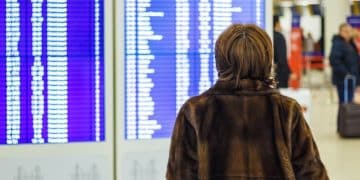Bypass Baggage Fees: 5 Proven Methods to Save $100+

Anúncios
Navigating airline baggage fees can be costly, but employing strategic packing techniques and utilizing smart travel methods can effectively circumvent these charges, potentially saving travelers over $100 on each trip, ensuring a lighter and more economical journey without sacrificing essentials.
Anúncios
In the evolving landscape of air travel, ancillary fees, particularly those associated with luggage, have become a significant concern for many passengers. The once-standard practice of including checked baggage in the airfare has largely evaporated, replaced by a complex labyrinth of charges that can quickly inflate the cost of a trip. Understanding how to navigate and even avoid these fees is no longer a luxury but a necessity for the budget-conscious traveler. This article delves into Bypassing Baggage Fees: 5 Proven Methods to Travel Lighter and Save $100+, offering practical, verifiable strategies to lighten your load and, crucially, your wallet.
Mastering the Carry-On: The Ultimate Downsizing Strategy
One of the most effective and universally applicable methods to avoid checked baggage fees is to commit to traveling solely with a carry-on. This approach demands a significant paradigm shift in how one packs, moving from a “what if” mentality to a “what’s essential” mindset. The benefits extend beyond financial savings; traveling lighter means greater mobility, faster airport navigation, and less risk of lost luggage. However, successfully mastering the carry-on requires adherence to specific airline regulations regarding size and weight, which can vary considerably.
Each airline maintains its own set of rules for carry-on luggage, and these rules are rigorously enforced, especially in an era where overhead bin space is at a premium. Before even beginning to pack, it is paramount to consult the specific airline’s website for their current carry-on dimensions and weight limits. Many budget airlines, in particular, have strict limits, sometimes only allowing a personal item unless a separate fee is paid for a larger carry-on. This initial research can prevent costly surprises at the gate.
Anúncios
Strategic Packing Techniques for Maximum Space
Once armed with the carry-on dimensions, the focus shifts to maximizing the available space. This isn’t just about fitting more items; it’s about fitting the right items in the most efficient manner possible. Traditional folding methods are often inefficient, creating air pockets that consume valuable space. Rolling clothes tightly is a popular and often more effective alternative, as it reduces wrinkles and utilizes every inch of your bag.
- Compress bulky items like sweaters or jackets by rolling them tightly.
- Use packing cubes to compartmentalize clothing and compress soft items.
- Wear your heaviest items of clothing on the plane, such as bulky jackets or boots.
- Utilize the space inside shoes by stuffing them with socks or small items.
Another crucial aspect of strategic packing is minimizing liquid toiletries. The Transportation Security Administration (TSA) 3-1-1 rule for carry-ons dictates that liquids must be in containers no larger than 3.4 ounces (100 milliliters) and fit into a single quart-sized bag. Opting for solid toiletries, such as shampoo bars, solid perfumes, or powdered toothpaste, can significantly reduce reliance on liquid containers and free up precious space in your quart bag for other essentials. This mindful selection is a cornerstone of light travel.
Ultimately, fully embracing the carry-on lifestyle requires a systematic approach to what you bring. It forces a prioritization of necessities over desires and encourages creative thinking about multipurpose items. For instance, a pareo can serve as a beach towel, a scarf, or even a makeshift blanket, reducing the need for multiple single-use items. This deliberate choice to downsize not only saves money but often enhances the travel experience by simplifying logistics and reducing stress.
Leveraging Airline Loyalty Programs and Credit Card Perks
While the goal is often to avoid fees outright, there are scenarios where some baggage might be unavoidable due to the nature of the trip or duration. In such cases, smart travelers can turn to airline loyalty programs and specific credit card benefits to mitigate or eliminate these fees. These avenues offer a structured way to receive complimentary checked bags, often saving the traveler $30-$50 per bag, each way, which quickly adds up to over $100 on a round trip. This strategy, however, requires a degree of foresight and planning, ideally before booking.

Many airline-branded credit cards offer a suite of travel benefits, with the first checked bag free often being one of the most attractive perks. These cards typically come with an annual fee, but for frequent travelers, the savings on baggage fees alone can easily offset this cost after just a few trips. For example, a card offering a free checked bag for the cardholder and up to a certain number of companions could save hundreds of dollars a year for a family or group traveling together. It’s crucial to read the terms and conditions of these cards carefully, as benefits can vary widely.
Evaluating Credit Card Benefits and Elite Status Tiers
Beyond co-branded credit cards, achieving elite status within an airline’s loyalty program almost invariably includes complimentary checked baggage as a standard benefit. Elite status is typically earned by flying a certain number of miles or segments, or by spending a certain amount with the airline within a calendar year. While reaching the highest tiers might be challenging for leisure travelers, even lower-tier elite status can unlock valuable perks like free checked bags, priority boarding, and upgraded seating.
- Research airline-specific credit cards that offer free checked baggage.
- Understand the annual fees and how they compare to potential baggage fee savings.
- Explore pathways to elite status within airline loyalty programs.
- Consider strategic flight choices to consolidate miles and ascend status tiers.
It is important to evaluate whether the overall value proposition of these programs aligns with your individual travel habits. For infrequent travelers, the annual fee of a credit card might outweigh the potential savings if they only check a bag once a year. However, for those who travel multiple times annually, even just one checked bag per trip can justify the card’s cost. Similarly, pursuing elite status requires a commitment to a particular airline, which might not be ideal for those who prefer to shop for the cheapest fares across different carriers. Nevertheless, for the right traveler, these benefits represent a significant financial advantage in the battle against baggage fees, turning potential expenses into valuable savings.
Shipping Your Luggage: A Niche but Effective Solution
For those instances where carrying all your belongings, even in a carry-on, isn’t feasible, or when dealing with oversized and specialty items (like sports equipment or musical instruments), shipping your luggage ahead of time presents a viable, albeit less common, alternative. This method bypasses airline baggage fees entirely and can often be more cost-effective than paying exorbitant airline surcharges, particularly for heavy or oddly shaped items. It also offers the undeniable convenience of not having to drag luggage through airports.
Several specialized luggage shipping services exist, offering door-to-door delivery. These services work by allowing you to schedule a pick-up of your bags from your home or office, and they then transport them directly to your destination, whether it’s a hotel, a vacation rental, or even a cruise ship. The pricing for these services is typically based on the weight, size, and destination of your luggage, as well as the desired delivery speed.
Weighing the Costs and Conveniences of Shipping
While potentially more expensive than a single checked bag, shipping can become significantly cheaper than multiple checked bags, especially on international flights where fees escalate rapidly. It also eliminates the stress of handling heavy bags at the airport, navigating security with bulky items, and the inherent risk of airline misplacement. For extended trips or family vacations, where the volume of luggage naturally increases, this option becomes increasingly attractive.
- Compare shipping costs to airline fees, especially for multiple or oversized bags.
- Plan for delivery times; shipping requires more foresight than checking bags.
- Ensure adequate insurance coverage for valuable items.
- Consider the convenience factor—no heavy lifting at the airport.
The primary consideration when opting for luggage shipping is timing. Unlike checked bags, which arrive with you, shipped luggage might take several days to reach its destination. Therefore, this method requires advance planning to ensure your belongings arrive before or shortly after you do. It’s also wise to send only non-essential items, keeping crucial documents, medications, and a change of clothes in your carry-on during the flight. For certain types of travel, such as moving for an extended period or going on a long cruise, shipping can also be an environmental choice, potentially consolidating shipments and reducing the number of individual pieces handled by air. This strategy, while not for every traveler or every trip, provides a powerful tool in the arsenal against escalating airline fees.
Utilizing Personal Items to Their Fullest Potential
Beyond the carry-on suitcase, most airlines allow passengers to bring one “personal item” onboard. This often overlooked allowance is a goldmine for savvy travelers looking to avoid baggage fees. A personal item is typically defined as a smaller bag that can fit under the seat in front of you, such as a backpack, a laptop bag, a purse, or a small duffel bag. Maximizing the space within this personal item can significantly reduce the need for a larger carry-on, or even eliminate the need for a checked bag altogether, especially for shorter trips.
The key to fully leveraging your personal item is intelligent packing and understanding the airline’s specific dimensions for this category. While usually more lenient than carry-on dimensions, these limits still apply. Choosing a personal item that is soft-sided and expandable can be particularly advantageous, allowing it to conform to tight spaces and hold more than a rigid bag of similar dimensions. Many travel-specific backpacks are designed with this flexibility in mind, featuring multiple compartments and an ergonomic design.
Creative Packing and Essential Items for Your Personal Bag
Think strategically about what goes into your personal item. This is the ideal place for items you’ll need during the flight, such as entertainment (books, tablets), snacks, medications, travel pillows, and even a light change of clothes or a compact set of toiletries. By moving these essentials out of your main carry-on, you free up valuable space in the larger bag. For ultra-light travelers, the personal item can even serve as the sole piece of luggage for a quick weekend getaway, effectively bypassing baggage fees completely.
- Select a personal item that is soft-sided and maximizes internal volume.
- Pack flight essentials: entertainment, snacks, medications, chargers.
- Include a light change of clothes for emergencies or short trips.
- Utilize small pouches and organizers to keep items tidy and accessible.
Moreover, modern personal items often come equipped with features like padded laptop sleeves, USB charging ports, and hidden pockets, enhancing both convenience and security. By carefully selecting and efficiently packing your personal item, you can significantly reduce the overall volume of your luggage, making airport navigation smoother and, most importantly, further reducing the likelihood of incurring any baggage fees. This seemingly small detail represents a powerful technique in the broader strategy of economical travel.
Embracing the “Capsule Wardrobe” Mentality
One of the most transformative shifts in mindset for travelers aiming to avoid baggage fees is adopting what is often referred to as a “capsule wardrobe” mentality. This approach moves away from packing a wide array of single-use outfits and towards selecting a limited collection of versatile clothing items that can be mixed and matched to create numerous different looks. The core principle is intelligent curation over sheer volume, ensuring that every item packed serves multiple purposes and contributes to a cohesive collection.
A successful capsule wardrobe for travel typically involves neutral colors that can be easily paired, along with a few accent pieces. Fabrics that are lightweight, wrinkle-resistant, and quick-drying are highly desirable, as they reduce bulk and the need for excessive items. For instance, merino wool is an excellent choice for base layers due to its temperature-regulating and odor-resistant properties, allowing garments to be worn multiple times before needing a wash.
Selecting Versatile Items and Minimizing Footwear
The process begins by planning outfits around activities, rather than individual days. Consider the climate of your destination and the types of events or outings you anticipate. Instead of packing a separate shirt for each day, select 3-4 tops that can be worn with 2-3 bottoms, creating many combinations. The same principle applies to outerwear; a versatile jacket that can be dressed up or down is far more efficient than multiple specialized coats.
- Choose neutral colors for main clothing items that can be easily mixed and matched.
- Prioritize lightweight, wrinkle-resistant, and quick-drying fabrics.
- Limit shoes to 2-3 pairs: one comfortable walking pair, one slightly dressier versatile pair, and possibly sandals/flip-flops.
- Accessorize with scarves, jewelry, or belts to add variety without bulk.
Footwear is another significant contributor to luggage weight and bulk. Aim to limit yourself to two or, at most, three pairs of shoes for most trips: one comfortable pair for walking, one versatile pair that can be dressed up or down, and perhaps a pair of sandals or flip-flops if appropriate for the destination. By adhering to the capsule wardrobe philosophy, travelers can dramatically reduce the volume and weight of their luggage, making carry-on travel effortlessly achievable. This not only saves money on baggage fees but also simplifies the packing process and provides greater mobility during the trip.

| Key Method | Brief Description |
|---|---|
| 🎒 Master Carry-On | Pack efficiently to fit all essentials within airline carry-on limits, avoiding checked bags. |
| 💳 Loyalty & Credit Cards | Utilize airline credit card perks or loyalty status for complimentary checked baggage. |
| 📦 Ship Luggage | Send bags ahead via shipping services for bulky or numerous items, especially for long trips. |
| 🎒 Personal Item Max | Optimize your personal item for flight essentials and extra clothing, reducing main bag needs. |
Frequently Asked Questions About Saving on Baggage Fees
For domestic flights in the US, the first checked bag typically costs between $30 and $40, while the second checked bag can range from $40 to $70. These fees are usually per-bag, per-segment, meaning a round trip can quickly double the cost. Fees for oversized or overweight bags can be significantly higher, often reaching $100 or more per item.
While most major airlines include one standard carry-on bag for free, some budget airlines, particularly in the US and Europe, now charge for carry-on bags that do not fit under the seat. It’s crucial to check your airline’s specific policy before flying to avoid unexpected charges at the gate, which can be even higher than pre-paid checked bag costs.
The easiest method is to purchase a portable digital luggage scale, which are widely available and inexpensive. Alternatively, you can use a bathroom scale by weighing yourself, then weighing yourself while holding your packed bag. Subtract your weight from the combined weight to get your bag’s weight. This helps ensure compliance with weight limits.
For oversized or very heavy items (like sports equipment or large musical instruments), shipping can often be significantly cheaper than airline fees. Airlines sometimes charge hundreds of dollars for such items. Shipping services offer competitive rates, often with door-to-door convenience, making them a cost-effective alternative for specialty baggage.
Yes, if you’re traveling with a companion on the same reservation, you can pool your luggage allowance. For instance, if one person has a free checked bag allowance, they can check a bag on behalf of both of you, as long as it adheres to weight limits. This strategy is effective for reducing the number of chargeable bags for a group.
Conclusion
The realm of airline baggage fees, while initially daunting, is not an insurmountable barrier to affordable and stress-free travel. By strategically implementing one or a combination of the five proven methods discussed—mastering the carry-on, leveraging loyalty programs and credit card perks, opting for luggage shipping, maximizing personal item utility, and embracing the capsule wardrobe—travelers possess powerful tools to sidestep these often exorbitant charges. Achieving savings of over $100 per trip is not just a theoretical possibility but a practical outcome for those who approach packing and travel planning with foresight and ingenuity. These strategies not only make travel more economical but also foster a lighter, more agile, and ultimately more enjoyable journey, allowing adventurers to focus on the destination rather than the cost of getting their belongings there.





